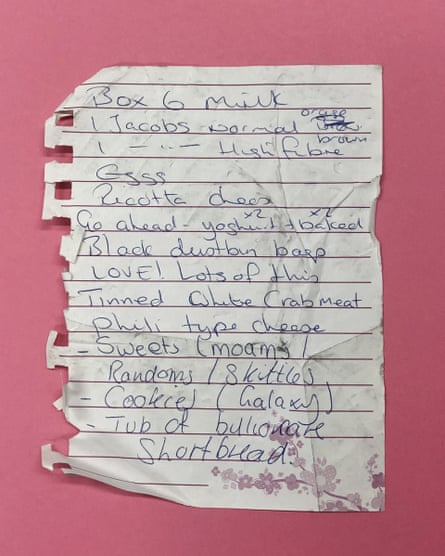YoIt all began in 2016 when Lucy Ireland Gray was standing outside her local Sainsbury’s in Bishop’s Stortford, Hertfordshire. “I spotted a scrap of paper on the pavement with an eye doodled on it,” she says. “Then I realized there were two sets of handwriting on it – someone had reused an envelope to make their shopping list. I became intrigued. Soon I started finding shopping lists all over the place.”
Gray has been picking up discarded shopping lists in her home town and beyond ever since. Friends and family soon started sending her lists, found around the UK. She has amassed almost 300 and is now curating an exhibition of these quirky, quoted glimpses into strangers’ lives.
“I’m naturally nosy,” she laughs. “I enjoy imagining the little stories behind the lists, filling in the gaps. I make judgments that might be horribly wrong but I’ll never know. I found one only yesterday that just said, ‘Yardley and hairspray.’ So I automatically pictured a glamorous older lady. That says as much about me as it does the list-maker. It’s the poetry of the everyday, open to interpretation.”
Gray is an archeology graduate and half-jokes that her eccentric hobby is itself a form of archaeology: “It is a similar process: finding a thrown-away artefact and building a picture from it.” She finds them mostly on the ground, often with a footprint, but also in baskets, trolleys or on shop shelves. She recently spotted one that had been carefully folded up into a tiny square and shoved in a hole in some brickwork opposite Waitrose.
The lists provide insights into consumer habits but also reveal how people compile lists. Dedicated shopping notepads with tickboxes are widespread. Post-its, perhaps filed from workplaces, figure highly. Others are jotted on cardboard torn from cereal packets or, in one case, the perforated oval lid of a tissue box. Many are written in capitals throughout. A select few are so well-organized that they’re arranged in order of the shopper’s route around the aisles.
Bread and milk are the most common items, followed by eggs and butter. “The groceries tend not to be terribly exotic,” says Gray. “Maybe people with more niche tastes shop online instead. You can often tell what meals they’re planning. You might go, ‘They’re definitely having stir fry tonight – or a barbecue this weekend.’ Avocados are surprisingly popular but nobody can spell them.”
Shoppers invariably write “blue milk” or “green milk” rather than whole or semi-skimmed. “Lists are full of such endearing little nuances,” says Gray. “They use shorthand and codes. STs is widely used to mean sanitary towels. I’ve noticed that people rarely use brand names. They might write Coke, Weetabix, Domestos or Philadelphia but everything else is generic. One list has a child’s cute pictures next to each entry – which is actually what Michelangelo did. He’d draw each item to help his illiterate servant from him.”
There’s something voyeuristically fascinating about these private documents. “You’d never go up to the conveyor belt and poke around in someone’s haul but they happily leave their list behind, which is essentially the same thing. They’re intimate, especially ones with personal notes to the shopper: ‘LOVE! Lots of this’ or ‘Love you millions, mumma.’”
Chancing upon them can be surprisingly emotional. “There’s one with spidery writing that made me cry,” she confesses. “Spellings say ‘salard’ and ‘chees’. It looks like it was a concerted effort to make, which melts my heart. I assume it’s someone very elderly but it could be a child learning to write.”

With the rise of online shopping and the ubiquity of smartphones, will the paper/cardboard shopping list soon die out? “I don’t think so,” says Gray. “Who can be bothered to type out a list when you can quickly scribble one in the kitchen? Going around supermarkets, I rarely see shoppers consulting a list on their phone.”
Gray’s collection stalled during lockdown, when retail cleanliness went into overdrive. The few she did find were heartwarming: “You could tell people were shopping for others – perhaps an elderly neighbor or isolating friend. There was a community element to them.” Now it’s back to business as usual.
“I love the lists because they’re unpretentious,” says Gray. “In a world where people often portray their lives as far more glamorous, a shopping list tells you how it really is. They’re refreshingly honest, even slightly vulnerable. A glimpse of the domesticity behind the mask. They’re a great leveller, too. Shopping lists have been around since ancient Mesopotamian times. They’re universal. Everybody writes them.”
Gray considered wallpapering her hall with her collection. She still might. For now, though, a beguiling display at the Museum of Brands in London has grown out of her hobby. “They’re little snapshots that create a story in your mind,” she says. “That story isn’t just about shopping. It’s about somebody’s life. That’s the beauty of this.”
www.theguardian.com
George is Digismak’s reported cum editor with 13 years of experience in Journalism